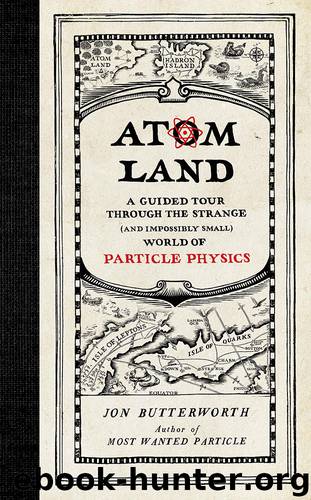Atom Land by Jon Butterworth

Author:Jon Butterworth
Language: eng
Format: epub
Publisher: The Experiment
20
Parity, Helicity, and Chirality
The process by which a neutron converts into a proton is called “beta decay.” It was in beta decay that the weak force sprang its biggest surprise.
The weak force interacts with all the quarks and leptons, but at the same time it only interacts with half of them, in a sense. Put another way, every city on the Isle of Leptons and the Isle of Quarks has an airport, but only half the inhabitants ever fly. Perhaps they are frightened or worried about climate change. Or maybe airport security is very picky. Whatever the reason, it is a puzzling fact. To work out what it means, we need to understand a concept known as chirality.
A chiral object is one that is not identical to its mirror image. It is also sometimes called “handedness.” Some molecules are chiral, having a right-handed version and a left-handed version. This is true of many biological molecules; DNA is chiral, for example: The twist in the double helix goes in a particular direction. So are sugars. Usually only one of the two possible chiralities is actually usable by living organisms.
The particles of our map, too, are chiral, and only one of those chiralities is affected by the weak force.
Spinning particles can be divided into two classes based on whether their spin is pointing in the direction the particle is traveling, or opposite to it. This is called the helicity.40 These are the only two possibilities for the helicity of a quantum particle with a spin of half a unit, such as the quarks and leptons of the Standard Model. If you imagine the particle coming toward you, you can think of the two helicities as corresponding to seeing the spin turning clockwise or counterclockwise, just as the twist of the DNA helix goes in one direction or the other. For a massless particle, these two helicities define the two possible chiralities of the particle.
This is strange behavior. The fact that there are two chiralities is not so surprising. Since we know that most particles have spin, there will be a handedness associated with the sense in which they spin, clockwise or counterclockwise, similar to the handedness of the twist in the double helix of DNA. What is surprising is that the W and Z bosons, which carry the weak force, “see” only one of those chiralities. A massless particle with its spin pointing in the opposite direction to the particle’s direction of motion will feel the weak force; a massless particle that has its spin pointing in the same direction as its motion will be invisible to the weak force. The inverse is true for antiparticles: Those with spin pointing in the same direction as their motion feel the force; those with it pointing against do not.
The fact that in nature, plants and animals produce, and make use of, only one chirality of some molecules is presumably due to random chance—some common ancestor happened to make and use one of them, and the success of that ancestor has meant that the original choice has been “locked in” ever since.
Download
This site does not store any files on its server. We only index and link to content provided by other sites. Please contact the content providers to delete copyright contents if any and email us, we'll remove relevant links or contents immediately.
The Complete Stick Figure Physics Tutorials by Allen Sarah(7135)
Secrets of Antigravity Propulsion: Tesla, UFOs, and Classified Aerospace Technology by Ph.D. Paul A. Laviolette(4984)
Thing Explainer by Randall Munroe(3782)
The River of Consciousness by Oliver Sacks(3414)
The Order of Time by Carlo Rovelli(3073)
How To by Randall Munroe(2912)
I Live in the Future & Here's How It Works by Nick Bilton(2842)
A Brief History of Time by Stephen Hawking(2819)
What If?: Serious Scientific Answers to Absurd Hypothetical Questions by Randall Munroe(2542)
The Great Unknown by Marcus du Sautoy(2535)
Midnight in Chernobyl by Adam Higginbotham(2388)
Blockchain: Ultimate Step By Step Guide To Understanding Blockchain Technology, Bitcoin Creation, and the future of Money (Novice to Expert) by Keizer Söze(2379)
Networks: An Introduction by Newman Mark(2264)
The Meaning of it All by Richard Feynman(2213)
Easy Electronics by Charles Platt(2207)
The Tao of Physics by Fritjof Capra(2164)
Midnight in Chernobyl: The Untold Story of the World's Greatest Nuclear Disaster by Adam Higginbotham(2077)
When by Daniel H Pink(2021)
Introducing Relativity by Bruce Bassett(2018)
